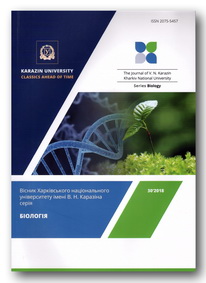Регуляція селективним світлом мітотичної активності кореневих меристем та ростових процесів проростків сої культурної з контрастною фотоперіодичною реакцією
Анотація
У роботі представлені результати дослідження впливу опромінення селективним світлом різного спектру – червоного (ЧС), 660 нм, зеленого (ЗС), 530 нм та синього (СС), 450 нм на проліферативну активність клітин кореневої меристеми, накопичення біомаси і ростові процеси в надземній та підземній частинах етіольованих проростків сої культурної. Як рослинний матеріал в роботі використовували контрастні за фотоперіодичною реакцією проростки сої культурної (Glycine max (L.) Merr.) двох сортів – короткоденного сорту Хаджибей та фотоперіодично-нейтрального сорту Ятрань. Стерилізоване насіння сої пророщували у чашках Петрі протягом 3-х діб в темряві за температури 22±1°С, після чого проводили активацію фоторецепторних систем опроміненням монохроматичним світлом різного спектру: червоним, зеленим та синім світлом щодня по 30 хвилин протягом 5-ти діб за допомогою LED матриць Коробова. Контрольні рослини культивували за тих же умов, але без опромінення селективним світлом. Відбір проб для аналізу проліферативної активності проводили у динаміці на – 6-ту, 7-ту та 8-ту добу експерименту, ростову реакцію проростків аналізували в кінці досліду – на 11-ту добу. Результати експериментів показали, що за опромінення селективним світлом різного спектру осьові органи проростків сої культурної реагують неоднаково: лінійні розміри надземної частини проростка більшою мірою залежать від дії ЧС, тоді як коренева система активніше реагує на дію СС. Надземна частина проростків за активації фітохромної системи шляхом опромінення ЧС змінює морфогенетичну програму розвитку зі скотоморфогенезу на фотоморфогенез. Водночас було показано, що опромінення усіма застосованими спектрами впливало на накопичення біомаси етіольованих проростків короткоденного сорту сої Хаджибей, тоді як у фотоперіодично нейтральної сої сорту Ятрань – лише опромінення ЧС. На кореневу меристему етіольованих проростків сої культурної сорту Хаджибей мало вплив опромінення ЧС та СС, тоді як проліферативна активність меристем коренів проростків сорту Ятрань більшою мірою залежала від дії СС та ЗС. Висловлюється припущення стосовно різного складу та активності фоторецепторних систем у проростків сої культурної з контрастною фотоперіодичною чутливістю, що проявляється у регуляції проліферативної активності меристем та ростових і морфогенетичних процесів.
Завантаження
Посилання
Avksentieva O.A., Batueva E.D. (2020). The effect of red light (660 nm) on proliferative activity and growth reactions in seedlings of plants with contrast photoperiodic reaction. The Journal of V.N. Karazin Kharkiv National University. Series «Biology», 34, 151–162. https://doi.org/10.26565/2075-5457-2020-34-16 (in Ukrainian)
Atramentova L.A., Utevskaya O.M. (2008). Statistical methods in biology: textbook. Gorlovka: Likhtar. 248 p. (in Russian)
Briggs W.R., Christie J.M. (2002). Phototropins 1 and 2: versatile plant blue-light receptors. Trends in Plant Science, 7(5), 204–210. https://doi.org/10.1016/S1360-1385(02)02245-8
Christie J.M. (2007). Phototropin blue-light receptors. Annual Review of Plant Biology, 58(1), 21–45. https://doi.org/10.1146/annurev.arplant.58.032806.103951
Christie J.M., Blackwood L., Petersen J., Sullivan S. (2015). Plant flavoprotein photoreceptors. Plant and Cell Physiology, 56(3), 401–413. https://doi.org/10.1093/pcp/pcu196
Franklin K.A., Praekelt U., Stoddart W.M. et al. (2003). Phytochromes B, D, and E act redundantly to control multiple physiological responses in Arabidopsis. Plant Physiology, 131(3), 1340–1346. https://doi.org/10.1104/pp.102.015487
Franklin K. A., Whitelam G. C. (2005). Phytochromes and shade-avoidance responses in plants. Annals of botany, 96(2), 169–175. https://doi.org/10.1093/aob/mci165
Franklin K. A., Quail P.H. (2010). Phytochrome functions in Arabidopsis Development. Journal of Experimental Botany, 61(1), 11–24. https://doi.org/10.1093/jxb/erp304
Golovatskaya I.F. (2005). The role of cryptochrome 1 and phytochromes in the control of plant photomorphogenetic responses to green light. Russian Journal of Plant Physiology, 52, 724–730 https://doi.org/10.1007/s11183-005-0108-4
Golovatskaya I.F., Karnachuk R.A. (2015). Role of green light in physiological activity of plants. Russian Journal of Plant Physiology, 62, 727–740. https://doi.org/10.1134/S1021443715060084
Graña E. (2018). Mitotic Index. In: A. Sánchez-Moreiras, M. Reigosa (eds). Advances in Plant Ecophysiology Techniques. Springer, Cham., 231–240. https://doi.org/10.1007/978-3-319-93233-0_13
Hoang H.H., Sechet J., Bailly C. et al. (2014). Inhibition of germination of dormant barley (Hordeum vulgare L.) grains by blue light as related to oxygen and hormonal regulation. Plant, Cell and Environment, 37(6), 1393–1403. https://doi.org/10.1111/pce.12239
Hopkins L., Bond M.A., Tobin A.K. (2002). Ultraviolet-B radiation reduces the rates of cell division and elongation in the primary leaf of wheat (Triticum aestivum L. cv Maris Huntsman). Plant, Cell and Environment, 25(5), 617–624. https://doi.org/10.1046/j.1365-3040.2002.00834.x
Kami C., Lorrain S., Hornitschek P., Fankhauser C. (2010). Light-regulated plant growth and development. Current Topics in Developmental Biology, 91, 29–66. https://doi.org/10.1016/S0070-2153(10)91002-8
Mishra S., Khurana J.P. (2017). Emerging roles and new paradigms in signaling mechanisms of plant cryptochromes. Critical Reviews in Plant Sciences, 36(2), 89−115. https://doi.org/10.1080/07352689.2017.1348725
Quail P.H. (2010). Phytochromes. Current Biology, 20 (12), 504–507. https://doi.org/10.1016/j.cub.2010.04.014
Reichler S.A., Balk J., Brown M.E. et al. (2001). Light differentially regulates cell division and the mRNA abundance of pea nucleolin during de-etiolation. Plant Physiology, 125(1), 339–350. https://doi.org/10.1104/pp.125.1.339
Schultz T.F. (2006). The ZEITLUPE family of putative photoreceptors. Handbook of photosensory receptors. Ed. W.R. Briggs, J.L. Spudich. Germany: Wiley VCH. 337–347. https://doi.org/10.1002/352760510X.ch16
Smirnova O.G., Stepanenko I.L., Shumny V.K. (2012). Mechanism of action and activity regulation of COP1, a constitutive repressor of photomorphogenesis. Russian Journal of Plant Physiology, 59, 155–166. https://doi.org/10.1134/S102144371202015X
Tilbrook K., Arongaus A.B., Binkert M. et al. (2013). The UVR8 UV-B Photoreceptor: perception, signaling and response. Arabidopsis book, 11, 11:e0164. https://doi.org/10.1199/tab.0164
Wang H., Haiyang H. (2015). Phytochrome signaling: time to tighten up the loose ends. Molecular Plant, 8(4), 540–551. https://doi.org/10.1016/j.molp.2014.11.021
Weller J.L., Ortega R. (2015). Genetic control of flowering time in legumes. Front. Plant Sci., Sec. Plant Genetics and Genomics, 6, 207. https://doi.org/10.3389/fpls.2015.00207
Zhmurko V.V. (2009). Photoperiodism of plants: physiological, biochemical and genetic aspects. Physiology of plants: problems and prospects of development. K.: Logos. P. 537–564. (in Ukrainian)
Zhong S., Shi H., Xue C. et al. (2012). A molecular framework of light-controlled phytohormone action in Arabidopsis. Current Biology, 22(16), 1530–1535. https://doi.org/10.1016/j.cub.2012.06.039
Автори залишають за собою право на авторство своєї роботи та передають журналу право першої її публікації на умовах ліцензії Creative Commons Attribution License 4.0 International (CC BY 4.0), яка дозволяє іншим особам вільно розповсюджувати опубліковану роботу з обов'язковим посиланням на авторів оригінальної роботи.




